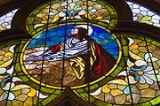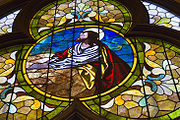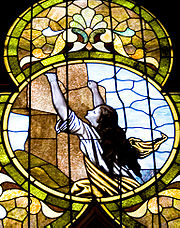
Lenox College
Encyclopedia


College
A college is an educational institution or a constituent part of an educational institution. Usage varies in English-speaking nations...
in Hopkinton, Iowa
Hopkinton, Iowa
Hopkinton is a city in Delaware County, Iowa, United States. The population was 681 at the 2000 census.-History:The city is the former home of Lenox College, a small school that closed in 1944. The old campus is still maintained as a museum.-Geography:...
that operated from 1859 until its closure in 1944. The institution was initially known as Bowen Collegiate Institute. The name was changed to Lenox Collegiate Institute in October 1864 and to Lenox College in 1884.
History
The school was affiliated with the Presbyterian Church. Several buildings that were part of the former college campus are on the National Register of Historic PlacesNational Register of Historic Places
The National Register of Historic Places is the United States government's official list of districts, sites, buildings, structures, and objects deemed worthy of preservation...
and are maintained by the Delaware County Historical Society as the Delaware County Historical Museum Complex. The college campus and the community of Hopkinton are also designated as stops on the Delaware Crossing Iowa Scenic Byways. The former building of the Hopkinton Reformed Presbyterian Church
Reformed Presbyterian Church of North America
The Reformed Presbyterian Church of North America , a Christian church, is a small Presbyterian denomination with churches throughout the United States, in southeastern Canada, and in a small part of Japan. Its beliefs place it in the conservative wing of the Reformed family of Protestant churches...
is located next to the campus, although it was not a part of the college's sponsoring church.
The centerpiece of the campus is the Civil War Monument, dedicated 17 November, 1865. The monument at the center of the campus was the first monument on a campus dedicated to the American Civil War. The majority of the young men of the college with the dean of the college as their captain signed on for military service shortly after the war began, causing the school to close temporarily. The monument is dedicated to them.
Construction of Old Main began in 1856. The Victorian style east wing was added in 1875. Clarke Hall, the dormitory for girls, was built in 1890. Doolittle Hall, constructed in 1900, contained the Library and Literary Societies. Finkbonner Hall (the gymnasium) was erected in 1916. Other buildings in the complex include the Hopkinton Depot, which was moved to the present site in 1969. The Reformed Presbyterian Church, with its remarkable Bavarian stained-glass windows, was dedicated in 1901 and donated to the Society in 1969. The one-room school was purchased and moved to its present location - next to the church - in 1971. A Farm Machinery Hall, which houses displays of horse-drawn farm equipment, was added in 1973. A second Farm Machinery Hall was built in 1982.
Presidents
- Dr. W.L. Roberts was selected as the first president, but resigned on December 12, 1859.
- Rev. Jerome Allen, Ph.D., 1859-1863.
- Rev. James McKean, Fall, 1863 until resignation May 6, 1864; entered army as a captain and died at Memphis, TN on July 9, 1864.
- Rev. James D. Mason, July, 1864 until formal resignation October, 1865.
- Rev. Jerome Allen, served from November, 1864 until June, 1866.
- Rev. Samuel Hodge, served September, 1866 until 1882.
- J. H. Ritchey, served 1882 until 1888.
- Rev. Alexander G. Wilson, served 1888 until fall 1894.
- Rev. Hugh Robinson, first alum (1888) to serve as president, 1894-1896.
- Andrew G. Wilson, alum (1880), became president in spring 1896 and served until spring 1902.
- Rev. Francis William Grossman, accepted presidency in February, 1902 and resigned July, 1906.
- Dr. E. E. Reed, served from summer 1906 through spring 1915; previously served as president of Buena Vista CollegeBuena Vista UniversityBuena Vista University is a private 4-year college located in Storm Lake, Iowa. Founded in 1891 as Buena Vista College, it is affiliated with the Presbyterian Church. The university's campus is situated on the shores of Storm Lake, a natural lake...
in Iowa and then served as president of Westminster College in Fulton, Missouri after leaving Lenox. - Dr. A. St. Clair Mackenzie, served from fall 1916 until his resignation on August 1, 1917.
- Dr. J.F. Hinkhouse, served from July 1, 1919 until 1924.
- Dr. W.W. Carlton, alum (1884), was in poor health and the institution was effectively under leadership of Dean E.V. Laughlin until his death in November 1938.
- Rev. Frank Allen, served from 1938 until the decision was finally made to close the institution after the spring semester 1944.
Alumni
- Samuel CalvinSamuel Calvin (geologist)Samuel Calvin was Iowa's first systematic geologist, helping to make the first bedrock and landform maps of Iowa, as well as leading geological research throughout the state. He was born in Scotland, attended Lenox College in Hopkinton, Iowa, where he later taught. One of his collaborators was...
(1840-1911), pioneering Iowa geologist, professor at the University of IowaUniversity of IowaThe University of Iowa is a public state-supported research university located in Iowa City, Iowa, United States. It is the oldest public university in the state. The university is organized into eleven colleges granting undergraduate, graduate, and professional degrees... - Charles Vaill Laughlin--taught political science at Lenox College (1932-1932, 1938-1939) and law at Washington & Lee University (1940-42, 1946-1977)
- Thomas H. Macbride--president at University of IowaUniversity of IowaThe University of Iowa is a public state-supported research university located in Iowa City, Iowa, United States. It is the oldest public university in the state. The university is organized into eleven colleges granting undergraduate, graduate, and professional degrees...
(1914-1916) - James McKean (1880)--missionary to Siam, founder of leprosy hospital, now the McKean Institute
- John Campbell Merriam--paleontologist, professor at University of California,
- Charles Edward MerriamCharles Edward MerriamCharles Edward Merriam, Jr. was a professor of political science at the University of Chicago, founder of the behavioralistic approach to political science, and an advisor to several U.S. Presidents...
--professor at University of Chicago (1900-1940), president of American Political Science Association (1925) - Frank MerriamFrank MerriamFrank Finley Merriam was an American politician who served as the 28th governor of California from June 2, 1934 until January 2, 1939...
--auditor of Iowa (1899-1903), governor of California (1935-1939) - Daniel Russel--pastor, Rutgers Presbyterian Church in New York CityNew York CityNew York is the most populous city in the United States and the center of the New York Metropolitan Area, one of the most populous metropolitan areas in the world. New York exerts a significant impact upon global commerce, finance, media, art, fashion, research, technology, education, and...
(1915-1942) - David Stanton TappanDavid Stanton TappanRev. David Stanton Tappan was an American Presbyterian minister who served as president of Miami University from 1899-1902.Tappan was from a distinguished American family, the grandson of Benjamin Tappan and nephew of Edwin M. Stanton. Born in Steubenville, Ohio, he graduated from Miami...
, president of Miami UniversityMiami UniversityMiami University is a coeducational public research university located in Oxford, Ohio, United States. Founded in 1809, it is the 10th oldest public university in the United States and the second oldest university in Ohio, founded four years after Ohio University. In its 2012 edition, U.S... - H.C. Velte (1879)--missionary to India

